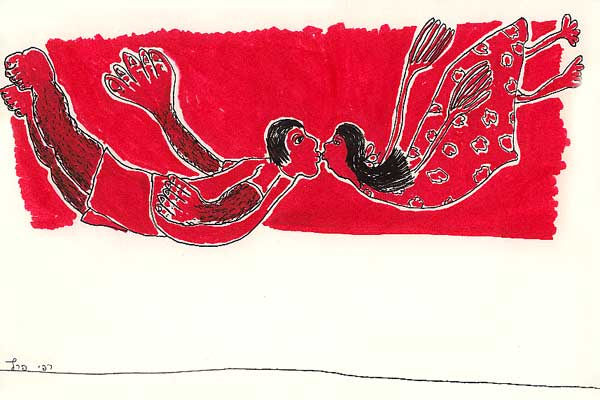Human connection is a funny thing, albeit an essential one.
Could you easily name the dozen people with whom you have most deeply connected in this lifetime?
Most likely you could.
If asked, I think that most of us could quickly come up with a fairly accurate list of the people who have touched us most deeply, and whom we have touched in return—those human beings who have, indeed, helped shape us into who we are today.
For most of us, these connections are still vividly present in powerful images and in body memories. The very thought of these connections inspires flights of memory, of fantasy, of nostalgia, and perhaps of grief. And, with the perspective of time, I have found that an understanding of the impact of these connections only grows stronger.
I myself made such a list a couple of years ago—the same list I’m challenging you to make. As it turns out, it’s a list I treasure. I keep it in the top drawer of my desk, and it turns up every now and then when I’m rummaging through that drawer. I sometimes pull it out to ponder for a moment. It always provides a spark of recognition, and at least a few long thoughts.
That list of 14 human beings grabs my gut. Each name summons memories, energy, sometimes sadness. But the combination of all those names together on one list? Wow. Together they make up some kind of potent brew that defines me, describes me, and sums me up better than anything else I can imagine.
It is not an exaggeration to say it: Those people are my life.
Back to you.
Will you actually take a stab at writing your own list?
Careful, though. Trust your gut on this one. A common trap here is to think about who should be on the list. But no. Avoid that trap at all costs, or this experiment will not do you any good at all. For just a moment, notice who really is on that list—without any intervention by the part of your mind that likes to manage these things. Go beneath the impulse to censor.
Oh, and by the way, there are a couple of people on my own list that I have never even met. Indeed, one of them has been dead for 200 years. Yeah: Ludwig van Beethoven. How could I possibly leave him off the list? Beethoven changed my life. (My piano teacher herself noticed it one night: “You seem to have some kind of powerful connection with him, with Beethoven. Are you aware of that?” Of course I was. But I was moved that she noticed.) (I don’t think the parenthesis is required here)
Have you had a Beethoven in your life? My twin sister, Sandy, put Saint John of the Cross on her list. My friend Dan put down an obscure seventeenth-century Jesuit priest. My friend Brian included Andrew Carnegie.
If you really trust your instincts as you make your list, I’ll bet you’ll be surprised at who ends up on the page. Some of them you may not even actually like that much. Maybe there is one individual whom you knew for only one night. But there he or she is. Knowing that person has touched you in ways you can barely describe or explain.
Most of us will have many friends throughout our lifetimes—friends of all shapes, sizes, and callings. Many of these are wonderful, meaningful friendships. Some are difficult. But some magic few of these are connections that have gone right to our soul. Some magic few of this entire flock have been doing the heavy lifting. Some magic few have become remarkably powerful keys to determining who we have become and who we will become.
These few move the inner tectonic plates of our being, our personalities, our souls.
These are the people I call Soul Friends.
As it turns out, Soul Friendships are the crucible in which we are evoked, created, affirmed, sustained, and transformed. Our relationships with our Soul Friends are the containers, the sparks, and the fuel required for psychological and spiritual development.
These special kinds of relationships can be brief and powerful, or long and sustained; they can exist across long distances and over vast spans of time; they can be highly charged connections within the family—parents, grandparents, siblings—or they can be friendships or relationships at school or at work. Occasionally, they can be powerful connections with complete strangers.
Just over the past decade, we have begun to understand how interpersonal experience shapes the growth of the neural networks in the brain, thanks to the precise findings of contemporary neuroscience. We know that “tuning in” to another mind, another self, another brain, is absolutely essential to the development of the self. The self is, in fact, almost entirely a social and interpersonal creation.
Almost all significant human development and transformation happens in the context of interpersonal connection. From the beginning of life to the end, what we might call “the real stuff” happens in the context of the relational field in which we’re submerged. Important relationships are at the core of growth, change, health, and optimal states.
And yet, strangely, these relational containers are often minimized or ignored altogether in our thinking about the mechanisms of change. In our spiritual journeys, for example, we focus primarily on theology, philosophy, the practice of prayer or meditation or yoga, the performing of good works, the development of faith in a higher power, or consciousness itself. But notice: In the background always lie these relationships, these Soul Friendships.
I have become fascinated by the powerful role these relationships play in our personal development, and in our capacity for change. And so I have investigated them in some depth.
You might be surprised, as I was, to find that the people on your list of Soul Friends will almost certainly fall into a pattern. Many of them will fall into a number of predictable, but nonetheless exciting, categories—categories that have technical names, or roles, in the psychological literature.
The people on your list have probably played one or more of the following essential roles in your psychological and spiritual development:
>> They have elicited in you a feeling of being safely and securely held and soothed, and have provided for you—with their very bodies and minds—a safe holding environment into which you could both relax and expand. We’ll call this Soul Friend “The Container.”
>>They have inspired in you a deep feeling of belonging, and a concomitant sense of “alikeness” with others. We’ll call this kind of friend—along with Dr. Heinz Kohut, who coined the term—”The Twin.”
>> They have challenged you, opposed you, confronted you, and frustrated you—but in ways that have turned out to be salutary for your soul. We’ll call this Soul Friend “The Noble Adversary.”
>>They have seen something special in you and have reflected you back to yourself in important ways, surprising ways—maybe even at times puzzling or infuriating ways. This Soul Friend will be “The Mirror.”
>> You have recognized in them some gift that you sense you also have inside yourself. As a result, you have felt a mysterious—almost mystic—kinship with them. I’ve come to call this particular friend “The Mystic Friend.”
>> They have been irreplaceable companions as you’ve worked your way up the path toward an understanding of the meaning of your life. They’ve shared your struggles to understand, to make meaning, to express and fulfill your true self, and to see into the depths of your soul. They have become conscious partners and allies in your search for an authentic and fulfilled life. Let’s call this Soul Friend “The Conscious Partner.”
I hold it as a central premise that these are six forms of human connection that we must have in order to grow, to thrive, to develop, and to live fully. Much of our spiritual, psychological, and even physical growth takes place in the context of, and as a result of, these special relationships. And I believe that through recognizing and understanding the nature of these connections, we can more skillfully shape who we become.
The six mechanisms of transformation, then, as I have described them, are:
>> Containment
>> Twinship
>> Adversity
>> Mirroring
>> Mystic resonance
>> Conscious partnership
“We build our buildings, and afterwards they shape us.” ~ Winston Churchill
Likewise, we build our relationships, and then they shape us.
Once we understand the true role of Soul Friendships and precisely how they work—how they function to support self-development and self- realization—we are in a position to consciously use them for our growth. We can then begin to systematically create for ourselves a “surround” of highly effective relationships that will continue to evoke, affirm, and sustain our most mature selves.
To reach this place of understanding, I really do suggest that you begin by making “the list.” Just give it a stab. Write it on the back of an envelope or make a formal chart. It doesn’t matter. Just get it on paper. You can revise it as we go along. (By the way: I’ll bet your list will surprise you.)
You may want to write—or journal—about your own Soul Friendships. This would surely help you to ponder their meaning for your life. Even just a few paragraphs about each friend will likely help you to clarify your thoughts, and to see the meaning of the relationship in a new way.
Here’s another suggestion that you might find useful: As you write your list, see if you can dig through old scrapbooks and find just one picture of each of the friends noted on your list. Then, display these pictures together somewhere—somewhere convenient, where you can look at them regularly as you read and ponder each category of Soul Friends.
Look into the eyes of your friends and ask yourself: Who was this person to you? Who is this person for you now? Reconnect with this friend in your heart. Bring him, bring her, with you on the journey of exploration.
This is an excerpt from Stephen Cope’s new book Soul Friends: The Transforming Power of Deep Human Connection. The journey to our most fulfilled selves involves significant introspection, but in order to truly thrive as human beings, we must make the most of who we are in relation to one another. For more information or to buy the book, please click here. Reprinted with permission from Hay House, Inc.
~
Author: Stephen Cope
Image: Iloveart Iloveart/Flickr
Editor: Callie Rushton









Read 0 comments and reply